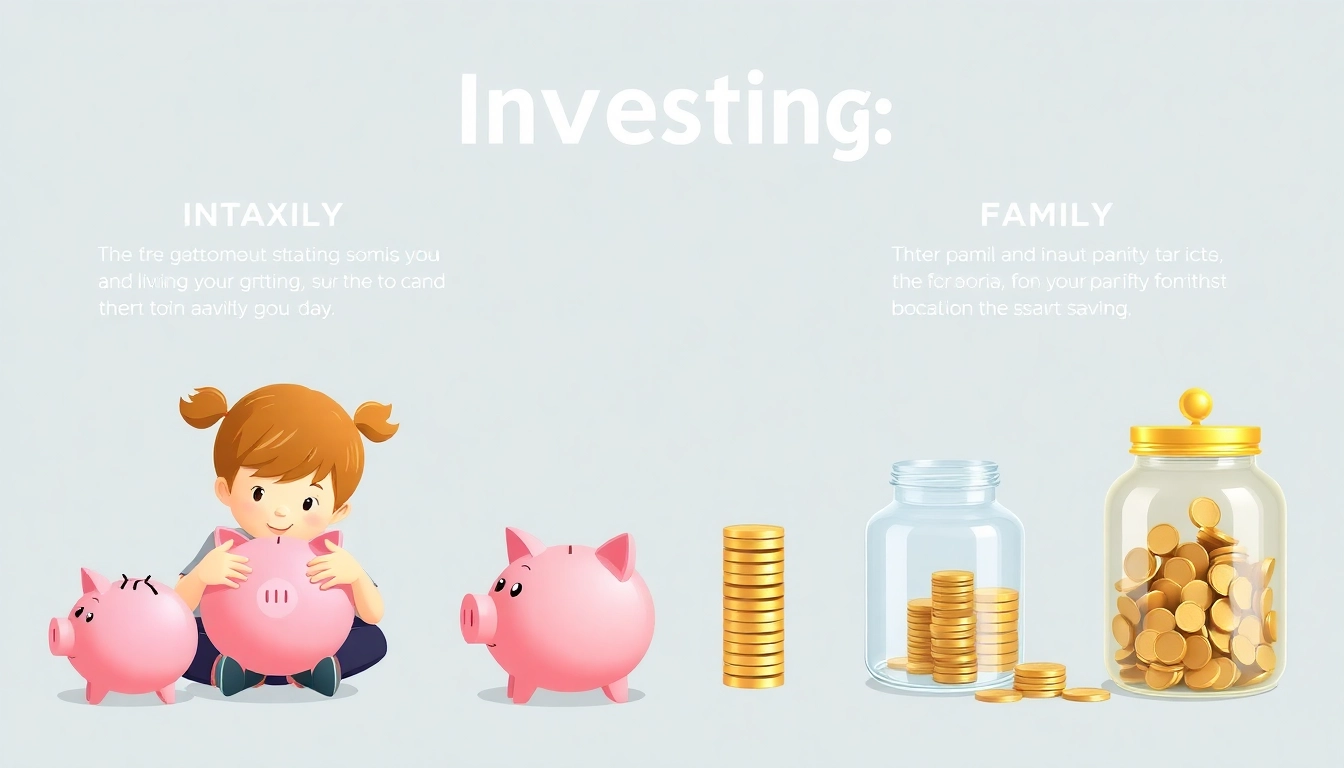Comprehensive Guide To Investing For Children: Securing the Future from a Young Age
Investing for children is an essential financial strategy that can provide lasting benefits, ensuring a stable and prosperous future for the next generation. With the ever-increasing costs of education, healthcare, and overall living expenses, starting early can significantly enhance a child’s financial security. As markets fluctuate and economic landscapes evolve—highlighted by recent news such as Asian stocks rising, commodities reaching new highs, and stock markets responding to global trends—it’s crucial for parents and guardians to understand how to navigate investment options effectively. For a detailed understanding, explore our Guide To Investing For Children that offers actionable insights for building a resilient financial foundation.
Understanding the Importance of a Guide To Investing For Children
Why early investing benefits your child’s future
Starting to invest early in a child’s life allows compound growth to work in your favor, dramatically increasing the accumulated wealth over time. Consider the case of a modest monthly investment: with a compound annual growth rate of 7%, an initial investment of £100 monthly from age 1 could grow to over £15,000 by age 18. Early investments also introduce children to financial literacy, fostering responsible money management from a young age. Moreover, early savings can be designated for future expenses such as higher education, first home deposits, or entrepreneurship ventures, providing a financial cushion during pivotal life moments.
Common challenges parents face in investing for children
Despite recognizing the importance, many parents encounter hurdles including limited financial knowledge, fear of market volatility, or short-term financial pressures. Additionally, understanding which investment vehicles align with a child’s long-term needs can be daunting. Time constraints and market unpredictability—especially in a world where recent news alerts us to fluctuating stocks and commodities—add layers of complexity. Overcoming these barriers requires education, disciplined planning, and strategic diversification to mitigate risks and maximize returns.
Step-by-Step Approach to Creating a Child Investment Plan
Setting realistic financial goals for your child’s education and future
The foundation of an effective investment plan lies in defining clear, achievable objectives. Whether aiming for university expenses, first home purchase, or starting capital for a future business, goals should be specific, measurable, and time-bound. For instance, setting a goal to accumulate £50,000 for university fees by your child’s 18th birthday guides your investment horizon and risk appetite. Use online financial calculators and seek expert advice to refine these goals and align your strategy accordingly.
Choosing the right investment accounts and vehicles
Selecting suitable accounts—such as Junior ISAs, Custodial Accounts, or Trust Funds—is critical. Junior ISAs, for example, offer tax-free growth and flexibility, making them popular among UK investors. Diversification across assets like stocks, bonds, and alternative investments helps balance risk and create resilient portfolios. Recent market developments, like the debut of China’s recent ecommerce giants or Gold reaching a four-month high, highlight opportunities across sectors. Tailoring investment vehicles to your risk tolerance and the child’s age ensures a balanced approach that adapts over time.
Establishing a disciplined savings routine
Consistency is key. Automating monthly contributions through direct debits reduces the temptation to make emotional or impulsive decisions. Setting up automatic transfers aligned with your financial inflows ensures steady growth. Additionally, periodic reviews—say quarterly or annually—help track progress and adjust for market conditions. For instance, recent trends such as Asian stocks rising or bonds coming under pressure suggest that rebalancing may be necessary to optimize returns while managing risk.
Maximizing Growth through Diversification and Risk Management
Balancing stocks, bonds, and alternative assets in a child’s portfolio
Creating a diversified portfolio minimizes exposure to market shocks. Equities—particularly growth stocks and emerging markets—offer high return potential but come with volatility. Bonds provide stability and income, balancing overall risk. Alternative assets like precious metals or commodities, which recently hit a four-month high on US rate-cut bets, can further hedge against inflation and economic uncertainties. A typical approach might involve 60% stocks, 30% bonds, and 10% in alternative investments, adjusted as your child approaches key milestones.
Understanding risk tolerance for long-term investments
Children’s investments generally have a long horizon, which allows for higher risk tolerance. However, individual circumstances, market conditions, and economic shifts—such as recent developments in gold prices or global equities—must inform risk appetite. Learning to accept short-term fluctuations for long-term gains is a vital skill. Regular portfolio assessments and staying informed on market trends help maintain a balanced strategy aligned with evolving economic realities.
Adjusting the strategy as your child approaches key milestones
As a child nears adulthood—say, 15 to 18 years old—reducing exposure to high-volatility assets and increasing holdings in safer investments may protect accrued wealth. For example, shifting from growth stocks to bonds or cash equivalents minimizes potential losses during downturns. Keeping an eye on macroeconomic trends—like the recent rise in gold or shifts in European stocks—can guide timely rebalancing to safeguard investments and ensure funds are available when needed.
Monitoring and Adjusting Your Child’s Investment Portfolio
Tracking performance and setting review intervals
Regular monitoring ensures your investment aligns with your goals. Annual reviews are common, but market conditions—such as the recent dips in crypto markets or bond yields—may necessitate more frequent adjustments. Use financial dashboards and statements to evaluate performance. Successful investors often track key metrics like CAGR (Compound Annual Growth Rate) and compare them to benchmarks such as FTSE 100 or MSCI indices, which recently showed gains amidst global uncertainties.
Rebalancing investments for better returns
Rebalancing involves realigning your portfolio back to your target asset allocation. For example, if stocks have appreciated significantly while bonds have declined, selling some equities to buy bonds can maintain risk levels. This disciplined approach helps lock in gains and reduces exposure to overperforming sectors that may be due for correction. Recognizing market signals like rising gold prices or geopolitical developments aids in timely rebalancing.
Adapting to market changes and economic shifts
Stay informed on global trends—such as the recent surge in Asian stocks, the US dollar near five-week lows, or the rising prospects of legal cannabis investments—to adapt your strategy. Economic shifts can impact sectors differently; for instance, recent news about European stocks’ slight increase and bond pressures highlight the importance of flexibility. A dynamic approach—reviewing and adjusting investments periodically—avoids unnecessary risks and capitalizes on emerging opportunities.
Educational Tools and Resources to Teach Kids About Investing
Interactive games and apps for financial literacy
Bringing investing concepts to children can be engaging and informative. Platforms like bank-sponsored simulators or apps such as “PiggyBot” and “Financial Football” introduce fundamental concepts like saving, investing, and risk management in a fun way. Recent market trends—like the advent of crypto trading platforms or inverse bitcoin ETFs in Hong Kong—can be explained through gamified tools that simulate real-world investing scenarios.
Family discussions and real-life examples
Open conversations about personal finance and current events help contextualize investments. Discuss recent headlines, such as gold reaching a four-month high on US rate cut expectations, or then relate these to investment principles. Sharing your own experiences and challenges encourages children to develop a resilient mindset toward market fluctuations and economic uncertainties.
Involving children in the investment process responsibly
As children mature, involve them in decisions like choosing investment accounts or reviewing portfolio updates. Use small, controlled investments, such as minor stock purchases or savings accounts, to teach ownership and responsibility. This participative approach fosters understanding and confidence, preparing them for independent financial management in adulthood.








